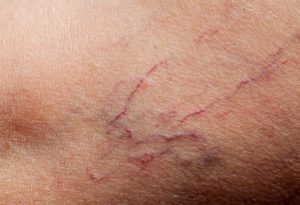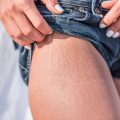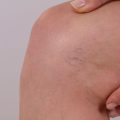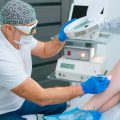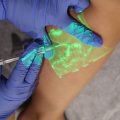Search a topic
Last updated on September 18, 2024
Do you have stretch marks or spider veins? These two conditions can look similar, so it’s not uncommon to mistake them for each other. To help you determine which one you have and what you can do about it, here’s how to tell them apart.
What are they?
Stretch marks are small tears that develop in the dermis, the lower layer of your skin. They form when your skin stretches too far and fast due to rapid weight gain, which can occur due to pregnancy, lifestyle factors, or an underlying medical condition.
Spider veins, meanwhile, are small, blown-up venules and capillaries. They may form due to sudden, excess pressure in the vein (as can happen during childbirth, pregnancy, or even weightlifting), or a malfunctioning valve that lets blood slip backwards and expand the vein.
What’s the difference between stretch marks and spider veins?
Appearance
In their early stages, stretch marks look a lot like spider veins. They may be flat or slightly raised and appear red, pink, or purple as the damaged skin is thin and its blood supply is more visible. However, as they fade, they look more like light cracks in the skin – indented and lighter than their surrounding skin. Stretch marks are also often wider than spider veins and may have tear patterns.
Causes
Spider veins pop up due to an issue with circulation. They may appear during pregnancy when progesterone relaxes the veins, blood volume doubles, and the expanding abdomen puts increased pressure on the veins. They may also be genetic – if your parents or grandparents had spider veins or varicose veins, you may inherit weaker vein valves. Sudden, increased pressure within the vein can also make it rapidly expand. Factors like an unhealthy diet and not getting enough exercise can also contribute.
Stretch marks, meanwhile, develop when the lower layers of skin tear, forming white to purple lines that may be indented. Pregnancy, rapid weight gain, weight loss, or growth (as happens during adolescence), and increased cortisone (which makes the skin lose elasticity) can all increase your risk.
Symptoms
Stretch marks and spider veins may or may not cause discomfort. Both of these conditions can result in some itching and pain around the area.
Prevention
To prevent spider veins, it’s important to avoid long periods of standing and wear compression socks on long-haul flights. If you do need to stand a lot, wear compression and try to move your legs or get off your feet as much as you can. Getting enough exercise and eating a vein-friendly diet can also help. These steps are especially important if you’re genetically predisposed to the condition.
As with spider veins, it’s not always possible to prevent stretch marks with 100% certainty. However, you can take steps to reduce your risk. First, live a healthy lifestyle to avoid rapid weight gain. Second, make sure you get enough vitamins A, C, D, E, and K to promote skin health. And lastly, moisturise your skin to keep it supple.
Complications
Stretch marks and spider veins are typically harmless. In some cases, however, they can point to an underlying issue. Stretch marks are often a symptom of Cushing’s Syndrome, where the body overproduces cortisol. Spider veins, meanwhile, may point to chronic venous insufficiency or varicose veins, which can cause uncomfortable symptoms of pain, itching, and swelling, and may even cause varicose eczema or ulcers. Incidentally, Cushing’s Syndrome can make the veins and capillaries appear more pronounced due to thinning skin, and in some cases make wounds slower to heal.
Can stretch marks or spider veins go away on their own?
Yes. If the spider veins formed during pregnancy, they may disappear a few months after your baby’s birth and your abdomen, blood volume, and hormone levels return to normal. If they form outside of pregnancy, however, you will likely need treatment to get rid of them. Stretch marks can also fade without intervention, but in some cases, they may not completely disappear.
Treatment for spider veins and stretch marks
Treating spider veins involves sealing the vein so your body can absorb it. Specialists do so through sclerotherapy, laser treatment, closure system therapy, or some combination of these. At Spider Veins Australia, we use Nd:YAG, CLaCS, and sclerotherapy, which are ideal for leg veins.
In most cases, stretch marks don’t need treatment. However, if they cause physical or aesthetic discomfort, you can try:
- Pulsed dye laser therapy
- Microneedling to promote collagen production
- Chemical peel
- Cosmetic surgery
Is it stretch marks or spider veins: the takeaway
These conditions are easy to mistake for one another. Both cause red or purple lines on the skin, both can result in itching and aches around the area, and they even have some crossover when it comes to causes. However, stretch marks develop when the skin tears due to a loss of elasticity or rapid growth while spider veins are a vein disorder. You can tell the conditions apart by appearance, as stretch marks become lighter, indented, and are often wider than spider veins.

